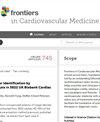Mini Review: the non-neuronal cardiac cholinergic system in type-2 diabetes mellitus
IF 2.8
3区 医学
Q2 CARDIAC & CARDIOVASCULAR SYSTEMS
引用次数: 0
Abstract
Diabetic heart disease remains the leading cause of death in individuals with type-2 diabetes mellitus (T2DM). Both insulin resistance and metabolic derangement, hallmark features of T2DM, develop early and progressively impair cardiovascular function. These factors result in altered cardiac metabolism and energetics, as well as coronary vascular dysfunction, among other consequences. Therefore, gaining a deeper understanding of the mechanisms underlying the pathophysiology of diabetic heart disease is crucial for developing novel therapies for T2DM-associated cardiovascular disease. Cardiomyocytes are equipped with the cholinergic machinery, known as the non-neuronal cardiac cholinergic system (NNCCS), for synthesizing and secreting acetylcholine (ACh) as well as possessing muscarinic ACh receptor for ACh binding and initiating signaling cascade. ACh from cardiomyocytes regulates glucose metabolism and energetics, endothelial function, and among others, in an auto/paracrine manner. Presently, there is only one preclinical animal model – diabetic db/db mice with cardiac-specific overexpression of choline transferase (微型综述:2 型糖尿病中的非神经元心脏胆碱能系统
糖尿病心脏病仍然是 2 型糖尿病(T2DM)患者的主要死因。胰岛素抵抗和代谢紊乱是 T2DM 的标志性特征,它们很早就会出现,并逐渐损害心血管功能。这些因素会导致心脏新陈代谢和能量代谢改变,以及冠状血管功能障碍等后果。因此,深入了解糖尿病心脏病的病理生理学机制对于开发治疗 T2DM 相关心血管疾病的新型疗法至关重要。心肌细胞具有胆碱能机制,即非神经元心脏胆碱能系统(NNCCS),可合成和分泌乙酰胆碱(ACh),并具有毒蕈碱样 ACh 受体,可与 ACh 结合并启动信号级联。来自心肌细胞的乙酰胆碱以自身/旁分泌的方式调节葡萄糖代谢和能量代谢、内皮功能等。目前,只有一种临床前动物模型--心脏特异性胆碱转移酶(Chat)基因过表达的糖尿病 db/db 小鼠--可用于研究活化的 NNCCS 对糖尿病心脏的影响。在这篇微型综述中,我们讨论了 NNCCS 的生理作用、NNCCS 激活与 T2DM 心血管功能之间的联系,并总结了目前对 S-亚硝基-NPivaloyl-D-青霉胺(SNPiP)的认识,SNPiP 是一种新型的 NNCCS 诱导剂,是调节 NNCCS 活性以治疗糖尿病性心脏病的潜在治疗策略。
本文章由计算机程序翻译,如有差异,请以英文原文为准。
求助全文
约1分钟内获得全文
求助全文
来源期刊

Frontiers in Cardiovascular Medicine
Medicine-Cardiology and Cardiovascular Medicine
CiteScore
3.80
自引率
11.10%
发文量
3529
审稿时长
14 weeks
期刊介绍:
Frontiers? Which frontiers? Where exactly are the frontiers of cardiovascular medicine? And who should be defining these frontiers?
At Frontiers in Cardiovascular Medicine we believe it is worth being curious to foresee and explore beyond the current frontiers. In other words, we would like, through the articles published by our community journal Frontiers in Cardiovascular Medicine, to anticipate the future of cardiovascular medicine, and thus better prevent cardiovascular disorders and improve therapeutic options and outcomes of our patients.
文献相关原料
| 公司名称 | 产品信息 | 采购帮参考价格 |
|---|
 求助内容:
求助内容: 应助结果提醒方式:
应助结果提醒方式:


